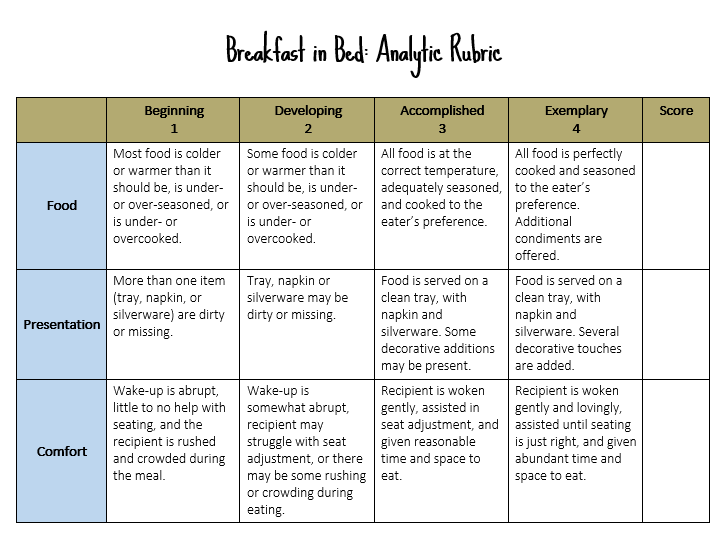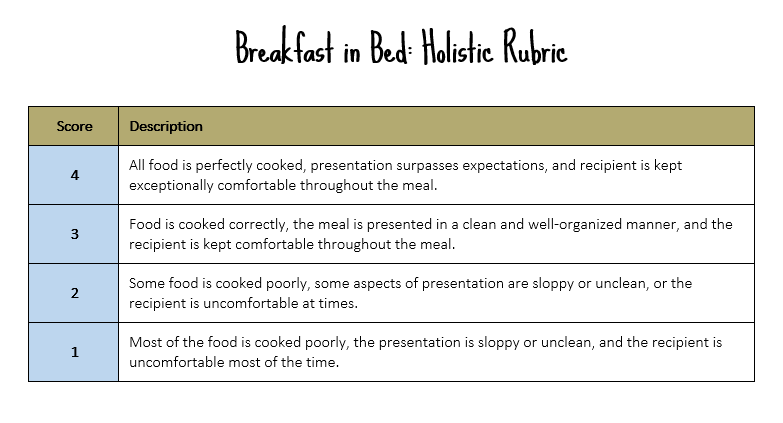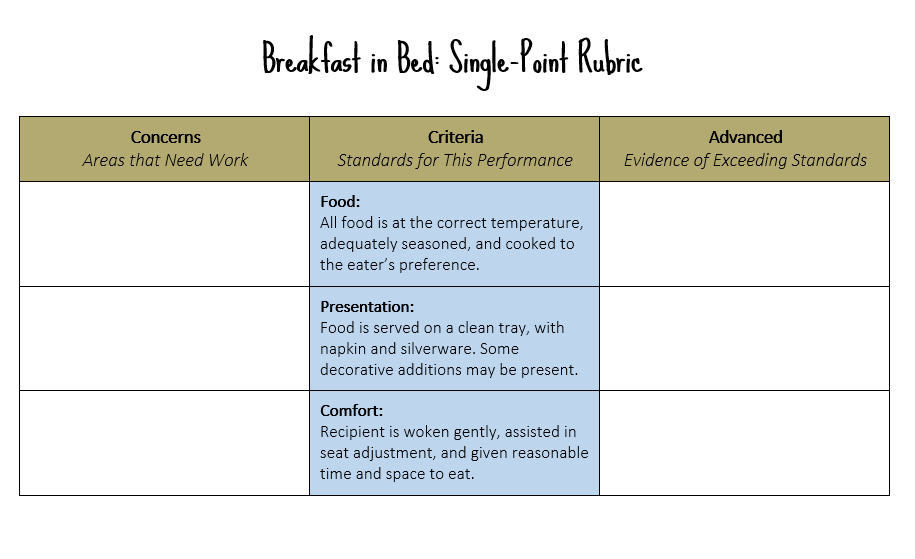All About Rubrics Book
| Site: | SCoPE - BCcampus Learning + Teaching |
| Group: | FLO MicroCourse: Rubrics OER (June 2022) |
| Book: | All About Rubrics Book |
| Printed by: | Guest user |
| Date: | Saturday, 27 December 2025, 12:17 AM |
1. What I Already Know?
Before you dive in to the content, ask yourself the following questions and jot down some notes:
- What does the word rubric mean anyway? Have you heard it used in places other than education circles?
- What do you picture when you hear the word rubric?
- How would you explain what a rubric is to a non-educator?
- What do you understand to be the benefits and challenges with using rubrics?
- What are you hoping to learn, specifically, about rubrics?
2. Funny name, simple idea
Have you ever wondered where the word, rubric, originated? It's actually a medieval term referring to the practice of using red ink to emphasize text (capital letters, section headings and names) in manuscripts. When the printing press came along and it was deemed too expensive to print in coloured ink the practice stopped. The term was then recycled to mean, "A set of instructions" or a "Statement of purpose or function" (Oxford English Dictionary).
But in modern education circles, the term rubric has it's own meaning. It is generally understood to be an assessment tool - something that comes after the task or performance. The thing is, I kind of like the original idea better - that a rubric is something that highlights or emphasizes what's important - a guide, a statement of purpose - something that comes before the task or performance.
This will be the theme or big idea of this micro-course: How and when you use the rubric is just as important as how you build it.

3. Assessment Rubrics
For education purposes, a rubric is considered to be a scoring guide or a set of criteria for grading. It's an attempt to communicate expectations of quality around a task. So, a good rubric should serve both instructor (the marker) and student (the learner).
Let's consider each perspective...
Instructor
Generally speaking, instructors have a good idea about quality from first glance. They can listen to an oral presentation, skim over an essay, or examine a carpentry join and pretty quickly know whether it is superior, satisfactory, or not-up-to-standard. They might even be able to assign it an overall grade without picking it apart too much. However, bias always creeps in. Sources of instructor bias include:
- Fatigue, when marking a large number of performances.
- Score creep - gradually marking more generously or harder.
- Getting stuck in the weeds and losing sight of the main objectives of task.
- Fading confidence in your own ability to judge (i.e. second-guessing).
- Rooting for a student you like, or looking with less kind eyes on the work of those students you don't.
How many of these have you experienced?
Students
Your high achieving students (those who know how to "play the game of school") will be looking for rubrics. They tend to use them as a checklist of what to do to get the top score. But many (if not most, in my experience) do not pay much attention to the rubric. How often do your students ask you, "What are you looking for?" even after you've given them the assignment instructions and rubric? Or, "What could I have done better" after you've returned a completed rubric?
This tells me that students really need two things:
- examples of quality
- feedback
Let's look at how we can build and use rubrics to meet both the needs of instructors and students.
4. Rubrics Everywhere
Evaluative scoring is used everywhere: Reality cooking shows, the CBC voting compass, avalanche decision making, sports competitions that use human judgment to score, or pretty much any time we choose between this or that, or pick a favourite something. In this case, we are subconsciously or consciously ranking criteria according to importance and then making a judgment. We are the "marker".
But sometimes we use evaluative scoring in day-to-day life as if we were the learner. If you've ever applied for a grant or a job, or created something according to specifications, you probably asked the same question your students do, "what are they looking for?" If you've wondered what makes a good test question, or asked your colleagues for some example course syllabi before building your own, you're using a rubric, of sorts.
Rubrics are extremely helpful tools. But they are just that - a tool.
5. The Good, Bad, and Ugly
Not all rubrics are created (or employed) equally. Let's consider the benefits and pitfalls of rubrics when used in our courses:
When designed well, rubrics...
- describe (or show) the expectations for quality of performance.
- provide a guide or checklist for students to follow.
- improve the reliability and validity of the evaluation/judgment.
- increase efficiency of marking.
- indicate the gaps in quality.
justify the score assigned to the performance or task.
At their worst, rubrics...
- are unidimensional and flat, despite the fact the performance never is.
- suggest that the sum of the "rubricized parts" equals the quality of the whole
- list a bunch of invalid criteria that are easy to check-off but misaligned with the outcomes.
- shackle professional judgement.
- decrease risk-taking by students.
- act as a ceiling on performance and subconsciously communicate that there is no more improvement to be had.
- are not used by learners for learning.
- are just more work for the instructor.
- can fail to capture that "je ne sais quoi" in overall performance.
6. This and That
Not all rubrics look the same. Continue reading for a description of the different kinds of available. The first three example rubrics given were created by Jennifer Gonzalez of Cult of Pedagogy (www.cultofpedagogy.com).Typical Analytical Rubric
A scoring guide that breaks down the task or performance into itemized parts and provides a description of the varying degrees of quality possible for each of the parts. Each criterion may or may not be weighted equally.

A scoring guide that connects an overall score to a description of the overall quality of the task or performance.

Single-Point Rubric
A feedback guide that breaks the task or performance into itemized parts and provides a description for the "proficient" level of quality. Space is provided to add written feedback that specifically targets concerns and points out standards of excellence. It may or may not be used to quantify the performance as well.

Marking Guide/Scoring Algorithm
A scoring guide that breaks the task or performance into itemized parts and provides a maximum score for each of the parts. No description is given.
Criteria |
Max Points |
|---|---|
| Food | /10 |
| Presentation | /5 |
| Comfort | /2 |
| Clean-up | /3 |